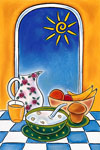|
Each year, more than 86,000 gymnastics-related injuries are treated in hospitals, doctors' offices, clinics, ambulatory surgery centers and hospital emergency rooms. More >>
|
|

Raising sports active kids is difficult, perhaps never more so than today. Parents feel pressure to help their kids succeed and to keep up with other parents in an increasingly winner-take-all society. Too often, parents feel that if they don't do everything for their child, they are bad parents. Some parents seem to take pride in how busy and stressed are their lives and those of their kids, as if it is a measure of how successful they are and how successful they must be as parents.
More >>
|
|
Safety Tip: From The American Academy of Orthopaedic Surgeons
Tips To Prevent Gymnastics Injuries: Each year, more than 86,000 gymnastics-related injuries are treated. The American Academy of Orthopaedic Surgeons offers the following tips to prevent gymnastics injuries: More >>
|
|
By Suzanne Nelson, .Sc.D, RD
 Once children enter elementary school, they begin to develop eating patterns that are more independent of a parent's influence and scrutiny. New activities and peers begin to influence food choices as your child is exposed to a variety of new foods and different social situations. Your child's food choices will tend to be repetitious, so that the foods they include in their diets remain relatively constant over time.
More >> Once children enter elementary school, they begin to develop eating patterns that are more independent of a parent's influence and scrutiny. New activities and peers begin to influence food choices as your child is exposed to a variety of new foods and different social situations. Your child's food choices will tend to be repetitious, so that the foods they include in their diets remain relatively constant over time.
More >>
|
|
An emergency medical plan should include an established set of actions to follow in the event of a medical emergency during a youth sports practice or game.
The plan should identify:
- Who will provide emergency first aid, including the use of an automatic external defibrillator (AED) in the event a player or spectator goes into cardiac arrest, such as from a blow to the chest causing commotio cordis
- Who and how paramedics or Emergency Medical Services (EMS) will be called
More >>
|
|
By Shane Murphy, Ph. D.
It is no easy task to be a parent of a young athlete. Hard enough are the tasks of helping the child learn how to handle the ups and downs of competition. But perhaps most challenging are the demands on your own coping skills - learning how to manage emotions that are repeatedly tested under trying conditions. More >>
|
|
A sprain is a stretch and/or tear of a ligament, the fibrous band of tissue joining the end of one bone with another that stabilizes and supports the body's joints. Because the outer ankle is more stable than the inner ankle, the foot is likely to turn inward (ankle inversion) from a fall, tackle, or jump. This stretches or tears ligaments; the result is an ankle sprain. More >>
|
|
Experts Wanted!
|
|
Do you know a Gymnastics coach in your community you think would be an ideal candidate for the MomsTeam editorial advisory board? Send his or her name
.
|
|

|
|
High School Gymnastics:
2008-09 Rule Changes and Revisions
|
|
New rules changes for high school girls gymnastics will allow for better understanding of skills and more consistent judging.
The National Federation of State High School Associations (NFHS) Girls Gymnastics Rules Committee adopted 52 rules changes, which will be effective with the 2008-09 school year, at its meeting last October in Indianapolis. The NFHS Board of Directors has approved the rules changes.
.More>> |
|
By Lindsay Barton
In 1992, the American College of Sports Medicine first recognized that girls and women in sports were particularly susceptible to three interrelated conditions - disordered eating, menstrual irregularity, and osteoporosis - that have come to be known as the "female athlete triad." More >>
|
|
By Brooke de Lench
In 1992, the American College of Sports Medicine first recognized that girls and women in sports were particularly susceptible to three interrelated conditions ?disordered eating, menstrual irregularity, and osteoporosis ?that have come to be known as the "female athlete triad."
More >>
|
|
 More women and girls are playing sports than ever before. The spectacular performance of women in the 1996 and 2000 Summer Olympics, along with the increase in the popularity of women's professional sports, have had a profound influence on little girls. "Be like Mike" has given way to "Be like Mia!" More>> More women and girls are playing sports than ever before. The spectacular performance of women in the 1996 and 2000 Summer Olympics, along with the increase in the popularity of women's professional sports, have had a profound influence on little girls. "Be like Mike" has given way to "Be like Mia!" More>>
|
|
by Brooke deLench
Here are some tips for staying organized when your child is playing sports:
- Put a nametag or write your child's name in permanent marker on everything (shoes, balls, bags, water bottles etc.)
- Tie a colored string or ribbon on your child's sports bag to make it easy to identify in a sea of bags (spending even an extra minute or two searching for the right bag when you and your child want to get on the road is frustrating and easily avoidable)
- Have your child keep all of his or her equipment together in the same place, preferably in a sports bag
More >>
|
|
 How soon to return to play after a head injury and the consequences of repeated concussions are two of the most important health-related issues in sports today. The approaches used by sports physicians in managing athletes who sustain concussions vary widely:
More >> How soon to return to play after a head injury and the consequences of repeated concussions are two of the most important health-related issues in sports today. The approaches used by sports physicians in managing athletes who sustain concussions vary widely:
More >>
|
|
The National Athletic Trainers?Association recently released a set of recommendations for precautions that should be followed by parents, coaches, athletic trainers, other health care professionals and participants in secondary school athletics, in order to prevent the spread of communicable and infectious diseases.
More >>
|
|
The first four steps of first aid for such injuries such as ankle sprains are known by the acronym "RICE," which stands for rest, ice, compression, and elevation:
- Rest. When your child is injured, small blood vessels at the injury site rupture and cause tissue bleeding, which, in turn, causes bruising and swelling.
More >>
|
|





























































 Once children enter elementary school, they begin to develop eating patterns that are more independent of a parent's influence and scrutiny. New activities and peers begin to influence food choices as your child is exposed to a variety of new foods and different social situations. Your child's food choices will tend to be repetitious, so that the foods they include in their diets remain relatively constant over time.
Once children enter elementary school, they begin to develop eating patterns that are more independent of a parent's influence and scrutiny. New activities and peers begin to influence food choices as your child is exposed to a variety of new foods and different social situations. Your child's food choices will tend to be repetitious, so that the foods they include in their diets remain relatively constant over time.

 More women and girls are playing sports than ever before. The spectacular performance of women in the 1996 and 2000 Summer Olympics, along with the increase in the popularity of women's professional sports, have had a profound influence on little girls. "Be like Mike" has given way to "Be like Mia!"
More women and girls are playing sports than ever before. The spectacular performance of women in the 1996 and 2000 Summer Olympics, along with the increase in the popularity of women's professional sports, have had a profound influence on little girls. "Be like Mike" has given way to "Be like Mia!"  How soon to return to play after a head injury and the consequences of repeated concussions are two of the most important health-related issues in sports today. The approaches used by sports physicians in managing athletes who sustain concussions vary widely:
How soon to return to play after a head injury and the consequences of repeated concussions are two of the most important health-related issues in sports today. The approaches used by sports physicians in managing athletes who sustain concussions vary widely:




